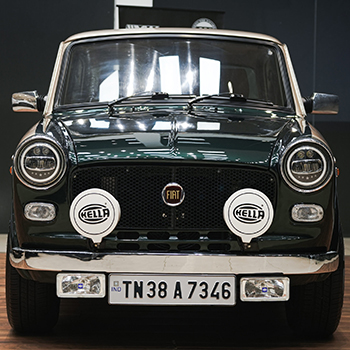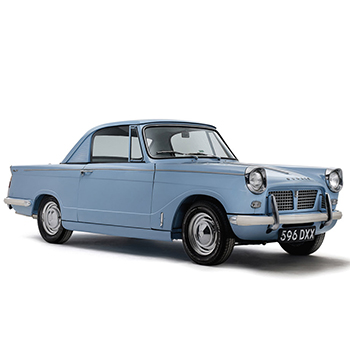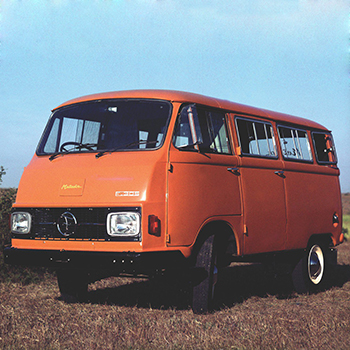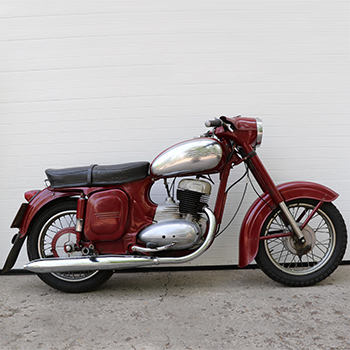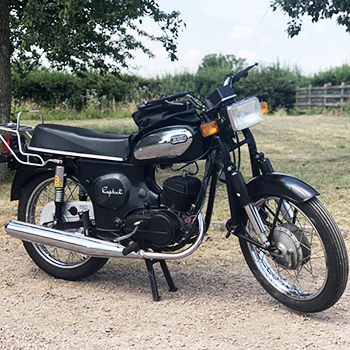Transport Automobiles
1961-1970
(5 items)
Transport Automobiles1961-1970
(5 items)
(5 items)
Premier Padmini 1964
Premier Automobiles Limited (PAL) launched the Premier Padmini in India in the mid-1960s, basing it on the Italian Fiat 1100D. The Padmini was small and fashionable for its time, with a sleek, European style that appealed to the middle class in urban India. It had rounded edges, a chrome grille, and simple yet graceful lines. Known for its dependability and fuel efficiency, it had a 1.1L inline-four petrol engine and a 4-speed manual gearbox. Although it was made in Mumbai, it was not designed in India. Aesthetically, the car was simple and sleek. It had a 3-box design with chrome-lined round headlights placed at corners with a giant grille at the centre housing the PAL logo and blinkers placed beneath it. It had curved front and rear bumpers crafted in chrome, door handles and a hub wheel cap also made up of chrome. Its cost-effective production was made possible by the local manufacturing of several of its pieces, including the body panels, engine parts and suspension systems, under licence from Fiat. The Premier Padmini became a cultural icon of Indian cities, particularly Mumbai, where it was a well-known black-and-yellow cab for many years due to its small size, ease of manoeuvrability, and fashionable appearance.
Details >>Standard Herald 1965
The Standard Herald 1965 was a compact sedan produced by Standard Motor Products of India Ltd. (SMPIL) under license from the British company Standard-Triumph. Although it was adapted for Indian conditions, it was based on the Triumph Herald. With a two-door or, subsequently, a four-door saloon body, a forward-hinged bonnet (facilitating quick engine access), and sharp, angular lines, the car had a unique design. The 1965 model was more sophisticated than many of the other models thanks to its 948 cc or updated 1147 cc gasoline engine, rear-wheel drive and independent front suspension. The interiors were simple but practical, usually with metal consoles and vinyl-covered seats, while the body panels were pressed steel with chrome accents on the grille and trimmings. Despite being regarded as rather underpowered, the car, which was manufactured in Chennai (formerly Madras), gained popularity among middle-class families in India due to its dependability and simplicity of maintenance.
Details >>Force Metador 1969
The Force Matador 1969 was one of India’s earliest light commercial vehicles, manufactured by Bajaj Tempo Ltd. (now Force Motors) under a license from Tempo-Werke, Germany. It was manufactured in India, not designed in India. Its boxy, practical van-like form made it perfect for transporting both passengers and luggage, and it quickly became common throughout Indian cities and towns. Powered by a 2- or 3-cylinder diesel engine, which is renowned for its toughness and fuel efficiency, the vehicle featured a front-engine, front-wheel-drive arrangement, which was uncommon in India at the time. The Matador's body was made from pressed steel panels, built on a ladder-type chassis, offering durability and ease of repair. The interiors were minimal, with metal dashboards and basic seats using leatherette or vinyl upholstery. Because of its adaptable design, it might be used as delivery vans, minibuses, or ambulances. In India's transport history, the Matador was particularly important for rural travel and small-scale trade in the late 1960s and early 1970s.
Details >>Jawa 250
Jawa Moto produced the Jawa 250 (1961), a Czech motorbike renowned for its sturdy engineering, smooth performance, and exquisite style. It had a 2-stroke, single-cylinder, air-cooled 248cc engine that produced 12–14 horsepower and was mated to a 4-speed gearbox. With a pressed steel backbone and swinging arm rear suspension, the 1961 model's recognisable "C" frame provided a more comfortable ride than rigid frames. With its chrome-finished fuel tank panels, enclosed chain guard, deep valanced fenders, and integrated headlamp and handlebar nacelle, its sleek design gave it a distinctly European look. With its 16-inch or 19-inch spoked rims (depending on the model), drum brakes on both wheels, and a weight of 135–140 kg, the Jawa 250 was both agile and sturdy. The automated oiling system and 2-stroke engine were renowned for their dependability and simplicity of maintenance. Beginning in the mid-1960s, Ideal Jawa Ltd, Mysore, licensed the Jawa 250 for local production, which led to its enormous popularity in India. Its snappy exhaust note, comfy suspension, and smooth acceleration made it a choice among riders for both everyday commuting and touring.
Details >>Rajdoot 175
The Rajdoot 175 (1962) was an Indian motorcycle based on the Polish SHL M11, produced under license by Escort Group (then ESPL). It had a 173 cc, single-cylinder, 2-stroke, air-cooled engine that produced about 7–8 horsepower and was connected to a 3-speed gearbox. The bike's telescopic front forks, two shock absorbers at the back, and tubular steel double cradle frame made for a comfortable yet robust ride. With its straightforward and useful design, deep mudguards, a flat single-piece seat, and a contoured fuel tank, it was ideal for Indian roads and load conditions. The Rajdoot 175 had spoked rims and drum brakes on both wheels, providing simple yet dependable braking. Its torquey 2-stroke engine gave good pulling power, which was especially helpful in rural regions and for transporting big goods, and its lightweight weight of 110–115 kg made it easy to use. Farmers, tradesmen, and rural commuters loved the bike because it was tough, easy to maintain, and could handle harsh terrain. The Rajdoot heritage in India began with the 1962 model, which later developed into the recognisable Rajdoot Standard and, subsequently, the Rajdoot Excel-T versions. It established itself as a reliable workhorse in India for many years by being a symbol of toughness and low operating expenses.
Details >>